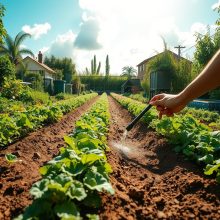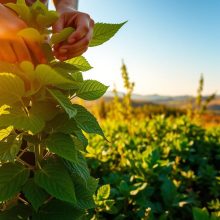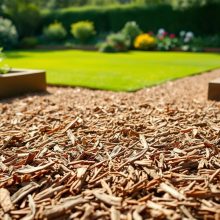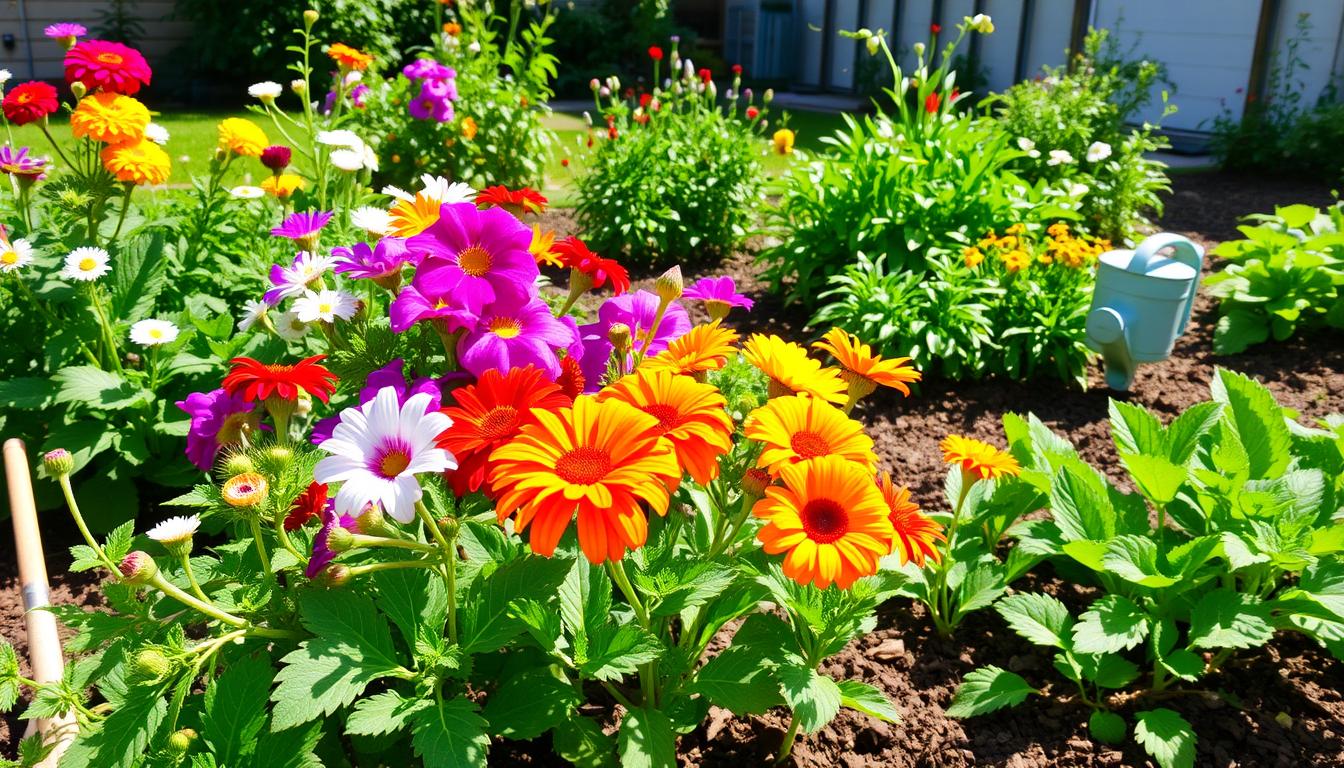Green Thumb Secrets: Essential Gardening Tips
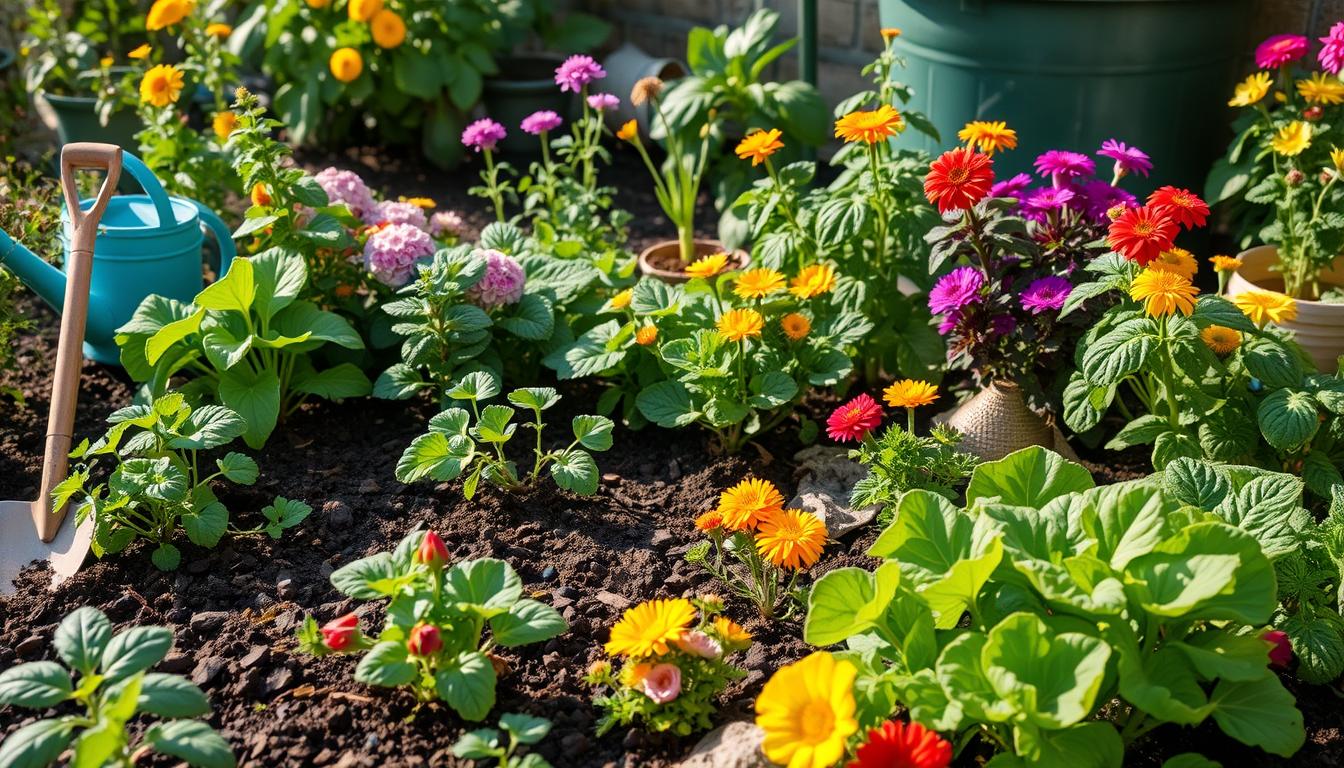
Unlock the secrets to a thriving garden with this guide. It’s perfect for both new and experienced gardeners. You’ll learn the key principles and tips for a lush, productive, and sustainable garden. We’ll cover everything from soil preparation to choosing the right plants and how to plant them together.
Learn the basics of gardening and the six key needs of plants. Understand the difference between cool-season and warm-season plants. Discover how good soil is crucial and how to improve it with compost, fertilizers, or natural materials.
Find out about watering plants the right way, the benefits of mulching, and how to pick and place plants. This guide will give you the skills and confidence to make your garden dream come true.
Key Takeaways
- Discover the six critical needs of plants for optimal growth
- Understand the differences between cool-season and warm-season plants
- Learn the importance of soil quality and the benefits of amending it
- Explore effective watering techniques for healthy plants
- Uncover the secrets of mulching for perfect soil microclimates
The Fundamentals of Successful Gardening
To grow a garden that thrives, start by knowing what plants need. They need sunlight, nutrient-rich soil, the right amount of water, and more. It’s also key to consider the temperature, how close plants should be, and who they should be planted with.
Meeting the Six Critical Needs of Plants
Plants need the right mix of things to do well. Most plants want at least 6 hours of sunlight a day. The soil should be rich and have the right pH level for nutrients. Plants also need about 1 inch of water each week, but too much can harm them.
Each plant has its own temperature needs. Cool-season plants like leafy greens do well in cooler weather and can handle light frosts. Warm-season plants like tomatoes and peppers like it warmer and should be planted after the last frost. Knowing when to plant and what these plants need is key to a great garden.
Understanding Cool-Season and Warm-Season Plants
Planting things correctly and with the right friends can make your garden better. Adding 2 to 3 inches of mulch around plants helps with weeds and keeps moisture in. Feeding your plants with good fertilizer can also make them grow and produce more.
By focusing on these important things, gardeners can make a great place for their plants to grow. Knowing how to care for plants and what they need is the secret to a garden full of life and food without using chemicals.
“Studies show that people who garden tend to eat more fruits and vegetables compared to non-gardeners.”
| Requirement | Cool-Season Plants | Warm-Season Plants |
|---|---|---|
| Sunlight | At least 6 hours | At least 6 hours |
| Soil pH | 5.5 – 7 | 5.5 – 7 |
| Moisture | 1 inch per week | 1 inch per week |
| Temperature | Cooler conditions, can tolerate light frost | Warmer weather, plant after last frost |
| Planting Time | Early spring | After last frost |
Soil Preparation for Optimal Growth
Healthy, nutrient-rich soil is key for a thriving garden. Start by testing your soil to find out its pH level and nutrient levels. Then, add compost, fertilizers, or other organic stuff as needed.
Get rid of weeds, debris, and loosen the soil with a fork or tiller. This makes it perfect for plant roots to grow and get the nutrients they need.
Importance of Soil Quality and Amendments
Having the right soil structure and mix is vital for plants to grow well and for your garden to succeed. Each soil type has its own needs, so it’s important to know what they are.
- Loamy soil, made of sand, silt, and clay in equal parts, holds moisture well, drains well, and lets oxygen to plant roots.
- Clay soil, with tiny particles, holds too much water, drains poorly, and lacks oxygen. Adding organic matter helps it.
- Sandy soil, with big particles, drains fast, losing nutrients. You need to add compost and well-aged manure.
The ideal pH for most garden veggies is between 6.0 and 7.0. This lets microbes work well and plants get the nutrients they need. Nitrogen, phosphorus, and potassium are key for growth, health, and fighting diseases.
Adding things like compost, aged manure, leaf mold, and coconut coir helps soil. These improve its structure, fertility, and how well it holds nutrients. A soil test can show what nutrients are missing and help you fix it.
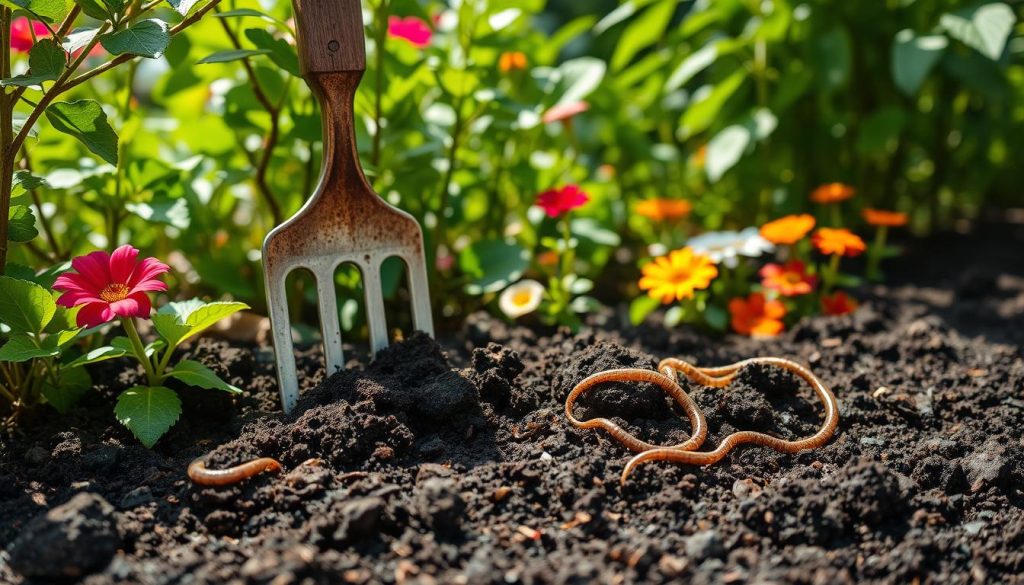
“Understanding soil composition, pH levels, and nutrient requirements is essential for successful gardening and plant growth.”
Getting your soil ready is a key step in making a garden last. By meeting the soil’s needs, you create the best conditions for your plants. This leads to a healthy, thriving garden.
Watering Techniques for Healthy Plants
Proper watering is key to a thriving garden. It’s important for houseplants, container gardens, or large outdoor areas. Knowing the best watering methods can greatly improve your plant’s health.
Water deeply but not too often. This helps plants grow strong roots that can handle droughts better. Shallow watering can cause root rot, so check the soil moisture and adjust your schedule as needed.
Each plant type needs different amounts of water. For example, cool-season grasses may need less water in summer. Vegetable gardens and raised beds usually need about an inch of water each week.
Soil type affects how much water plants need. Sandy soils drain fast, so plants may need more water. New plants and young trees need more water until they grow strong roots.
Mulching helps keep soil moist and controls temperature. Adding native and drought-resistant plants is also smart. They’re better suited to local weather and use less water.
Successful gardening means watching your plants and adjusting your watering. By following these tips and understanding your garden’s needs, you can keep your plants healthy with less water waste.
| Watering Needs by Plant Type | Recommended Watering Frequency |
|---|---|
| Vegetable gardens or raised beds | 1 inch of water per week |
| Cool-season grasses (e.g., Kentucky bluegrass, tall fescue) | May go dormant in hot, dry weather |
| Newly planted lawns | Require regular watering to establish |
| Trees | Water the entire canopy area, focusing on the root ball |
| Newly planted trees, shrubs, perennials, and seedlings | Require more frequent watering than established plants |
| Container plants | Need more frequent watering than in-ground plants |
A good rule is to give your plants about one inch of rainfall each week. This means soaking the soil six inches deep. By using these watering tips and adjusting for your garden’s needs, you can create a lush, vibrant space with less water waste.
The Art of Mulching
Mulching is a key gardening technique that helps with weed control, keeps the soil moist, and creates the perfect soil conditions. It’s important to pick the right type, amount, and timing of mulch for cool and warm-season plants.
Mulching for Cool- and Warm-Season Plants
Cool-season plants do well with a thick, moisture-holding mulch. Warm-season plants like a thinner layer to warm up the soil faster. By matching the mulch to each plant’s needs, gardeners help them grow best.
Creating Perfect Soil Microclimates
Proper mulching boosts the garden’s growing conditions for all plants. By adjusting the mulch’s timing and thickness, gardeners can make “perfect” soil spots for their plants. This customization ensures each plant gets the right soil temperature, moisture, and nutrients for growth.
| Mulching Materials Utilized | Usage and Non-Usage of Commercial Products |
|---|---|
|
|
“The use of mulch in gardening enhances the aesthetic appeal, soil health, water conservation, and application of eco-friendly principles.”
Plant Selection and Placement Strategies
Creating a successful garden means picking the right plants and placing them well. It’s key to choose plants that fit your local climate and growing conditions. Think about the temperature, rainfall, and sunlight your plants will get.
Choosing Climate-Appropriate Plants
For a garden to flourish, pick plants that fit your climate. Plants adapted to your area’s conditions need less care and stay healthier. Here are tips for picking the best plants:
- Use the USDA Hardiness Zone to pick plants that can handle your area’s cold.
- Go for plants that can survive with little water if your area is dry. Choose those that love moisture if it’s wet.
- Pick plants that love the sun for sunny spots and those that can handle shade for shady areas.
- Use native plants which are perfect for your local environment and need less upkeep.
| Plant Type | Preferred Climate | Examples |
|---|---|---|
| Shade Trees | Cool, moist climates | Oak, Maple, Beech |
| Flowering Shrubs | Temperate, well-drained soils | Azalea, Hydrangea, Lilac |
| Succulents | Hot, dry climates | Agave, Echeveria, Sedum |
By picking plants that fit your climate and placing them right, you can have a beautiful, easy-to-care-for garden. It will show off the natural beauty of your area.
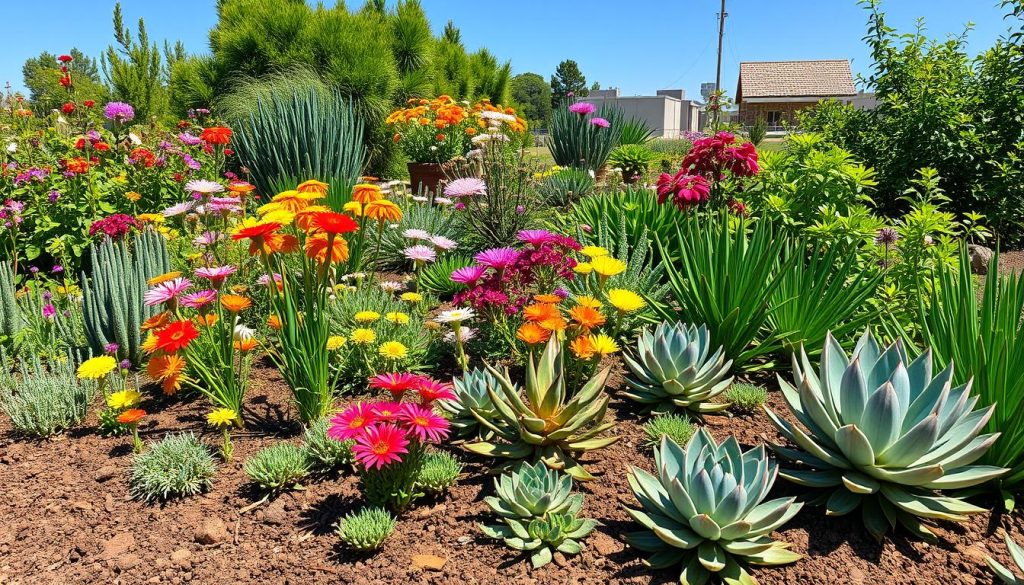
Companion Planting for a Thriving Garden
Growing a vibrant garden is rewarding, and a key to success is companion planting. This method involves growing plants together to help each other. It makes your garden healthier and more resilient.
Easy Companion Plant Groupings
Some of the best and simple companion plant pairings include:
- Tomatoes with basil and marigolds: Basil keeps aphids away, and marigolds keep insects off.
- Carrots with radishes and chives: Radishes prepare the soil for carrots, and chives keep carrot flies away.
- Beans with corn and squash: Together, they form “the three sisters.” Beans fix nitrogen, corn supports beans, and squash keeps the soil moist.
These plant groups fight pests and make the soil better. They also make your garden more diverse and strong. Adding companion planting to your garden makes it thrive with less work.
| Companion Plant Combination | Benefits |
|---|---|
| Tomatoes, Basil, Marigolds | Basil repels aphids, marigolds deter pests |
| Carrots, Radishes, Chives | Radishes loosen soil, chives deter carrot flies |
| Beans, Corn, Squash (“Three Sisters”) | Beans fix nitrogen, corn supports beans, squash shades soil |
Using companion planting, gardeners can have a garden that grows well with little work. It uses the natural benefits between plants. This method helps plants grow healthy and cuts down on harmful pesticides. It’s a green and smart way to grow a lot of food.
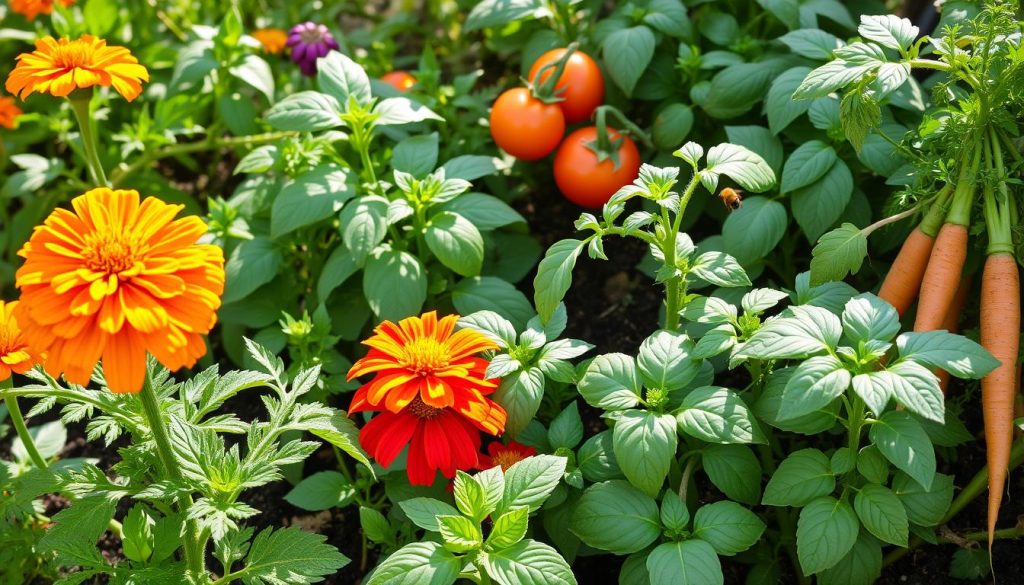
“Companion planting is like a symphony in the garden, where each plant plays its part to create a harmonious and productive ecosystem.”
Gardening Tools and Equipment
Having the right gardening tools and equipment is key to a successful garden. You’ll need basics like shovels, rakes, hoes, pruners, and trowels. For tougher jobs, tools like tillers, aerators, and sprinklers can help.
Quality matters with gardening tools. Ellen Hoverkamp, a botanic photographer, likes Foxgloves gloves for their water resistance and breathability. For pruning, Hoverkamp suggests ratcheting anvil pruners for extra strength.
For cutting thick branches, the Tabor Tools GG12 Anvil Lopper is a top pick. Genevieve Schmidt, a landscape designer, recommends the Radius Garden 203 Pro Ergonomic Steel Digging Fork for soil. She also likes the Garrett Wade Tulip Trowel for its durability.
| Tool | Recommendation | Expert |
|---|---|---|
| Gardening Gloves | Foxgloves water-resistant and breathable gloves | Ellen Hoverkamp, Botanical Photographer |
| Pruners | Ratcheting anvil pruners | Ellen Hoverkamp, Botanical Photographer |
| Loppers | Tabor Tools GG12 Anvil Lopper | Editors |
| Digging Fork | Radius Garden 203 Pro Ergonomic Steel Digging Fork | Genevieve Schmidt, Landscape Designer |
| Hand Trowel | Garrett Wade Tulip Trowel | Genevieve Schmidt, Landscape Designer |
Experts also recommend the King of Spades Model 38 Balling Spade for digging and lifting. The Tabor Tools Adjustable Metal Rake is great for removing leaves. And the Rogue Garden Hoe 575G is perfect for weeding.
For garden equipment, Genevieve Schmidt suggests the Tuff-Guard Hose and Bon Aire Ultimate Hose Nozzle for watering. Kitchen gardener Jeanne Kelley likes the Dramm One-Touch Rain Wand for watering plants gently. The Bloem Deluxe Watering Can is also a top choice for its design.
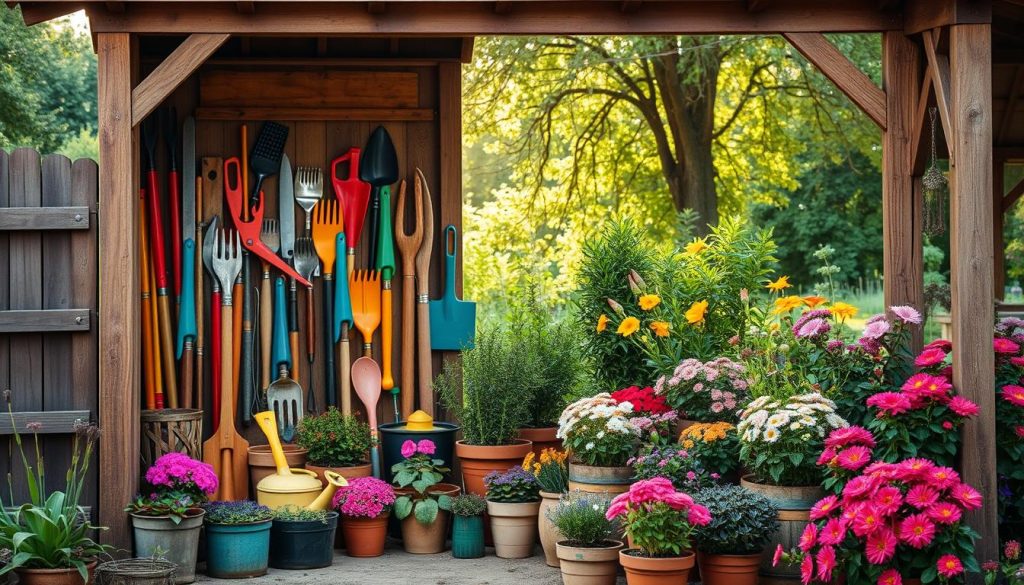
Investing in good gardening tools and equipment makes gardening better. Take time to pick the right tools for your needs and preferences.
Pest and Disease Management
Keeping a garden healthy means watching out for pests and diseases. Gardeners must be quick to spot and fix problems to help plants grow well. Using organic pest control is a great way to fight pests without harming nature.
Organic Pest Control Methods
Instead of using harsh chemicals, organic gardeners use natural ways to control pests and diseases. Some good methods are:
- Introducing beneficial insects, such as ladybugs and lacewings, to eat harmful pests.
- Using insecticidal soaps or neem oil to kill pests without harming the environment.
- Keeping the garden clean by removing weeds and debris to stop pests from breeding.
- Rotating crops to break the life cycle of pests in the soil.
- Picking plants that are naturally resistant to common diseases.
These organic methods help keep a garden healthy and balanced. They don’t use harsh chemicals. This is good for the plants, the environment, and the helpful insects that pollinate and control pests.
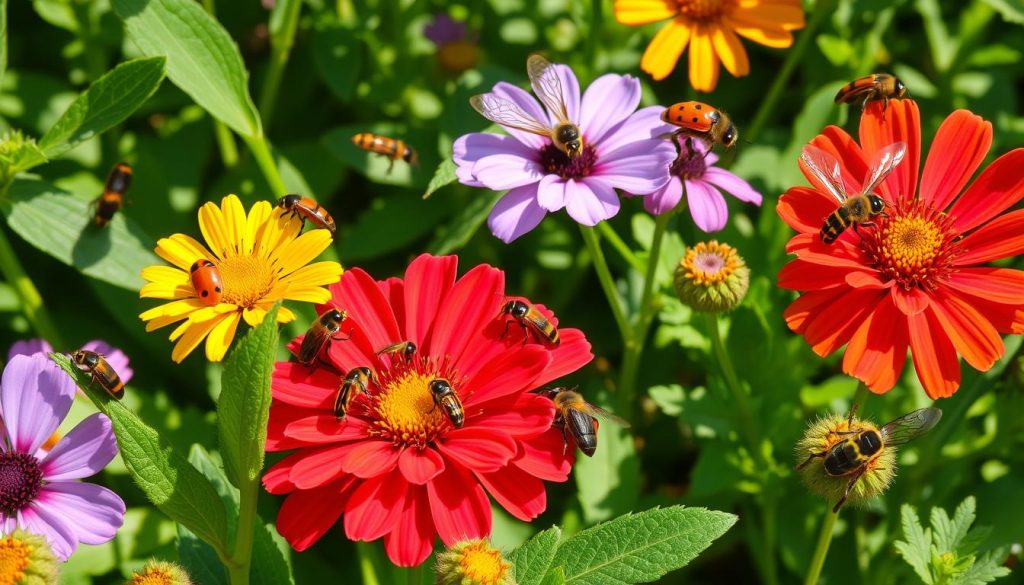
A garden with many different plants makes it hard for pests to live and spread. By keeping an eye on plants and encouraging many types of plants, gardeners can prevent problems. This creates a healthy, organic garden environment.
“A healthy, balanced garden ecosystem is the best defense against pests and diseases.”
With patience and organic gardening, gardeners can have a garden full of plants and no pests.
Garden Layout and Design
Creating a beautiful and useful garden takes careful planning. The way you place plants, paths, and other features can turn a simple green space into a peaceful oasis. By trying out different planting patterns, like raised beds or terraces, you can use space well and make your garden look good together.
It’s smart to split your garden into areas or blocks. This makes crop rotation easy, keeping the soil rich in nutrients. Put taller plants north and shorter ones south for the best sun exposure. Using companion planting helps plants grow well together and fight off pests. Intercropping lets you harvest more often by mixing fast and slow-growing crops.
If you have little space, think about using container plants and raised beds. Raised beds are 4 feet wide, 8 feet long, and 10-12 inches deep. They help with drainage and make reaching plants easy. Square foot gardening is another great way to use space. It divides the garden into small squares for better space use.
Adding things like trellises for climbing plants or mulch for keeping soil moist can improve your garden layout and design. These elements work together to make your garden both beautiful and useful.
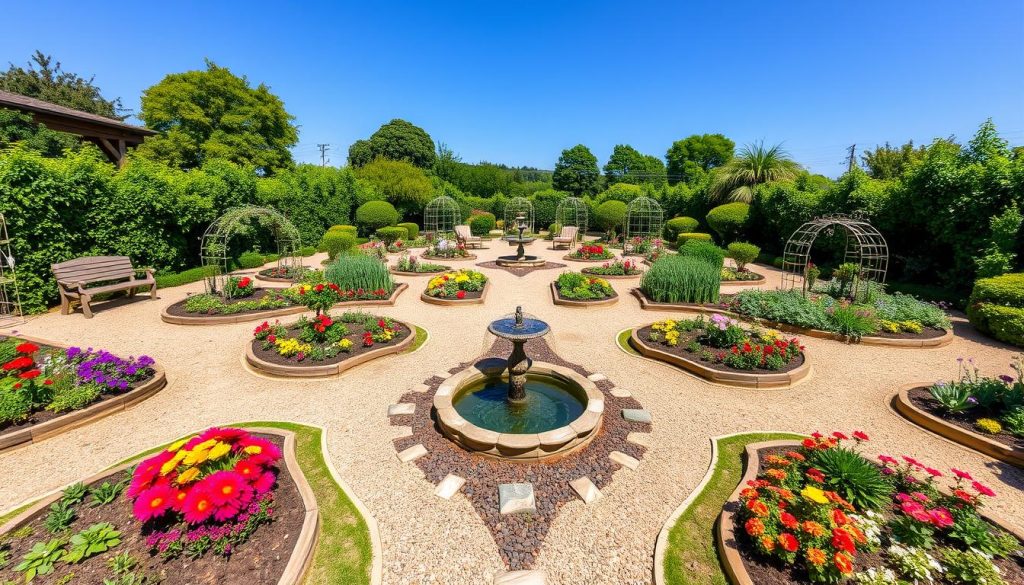
“A well-designed garden is a harmonious blend of function and aesthetics, where every element works in concert to create a truly captivating space.”
Gardening Tips for Beginners
Starting a garden can be both exciting and a bit scary for beginners. Whether you’re starting fresh or revamping an old garden, these tips will help you succeed.
Understanding how much sunlight your plants need is crucial. Most plants need at least 6 hours of sunlight to grow well. Picking the right spot for your garden is key to your plants’ health.
Getting your soil ready is vital for new gardeners. Aim for soil that drains well and has lots of organic stuff in it. Adding compost or well-aged manure can make your soil better, but avoid fresh manure to protect young plants.
- Start small and gradually expand your garden as you gain more experience.
- Choose plant varieties that will mature within your specific growing season.
- Stagger plantings of fast-maturing vegetables like beans and lettuce for a continuous harvest.
- Consider raised garden beds or containers if you have limited space.
Watering and feeding your plants right is key to success. Use a good hose with a sprayer or a drip system for watering. Feed your plants with a quality plant food like Miracle-Gro to help them grow strong.
To be a great gardener, start small, be patient, and enjoy the journey. With the right knowledge and a positive attitude, you’ll soon have a beautiful garden that makes you happy and feeds you too.
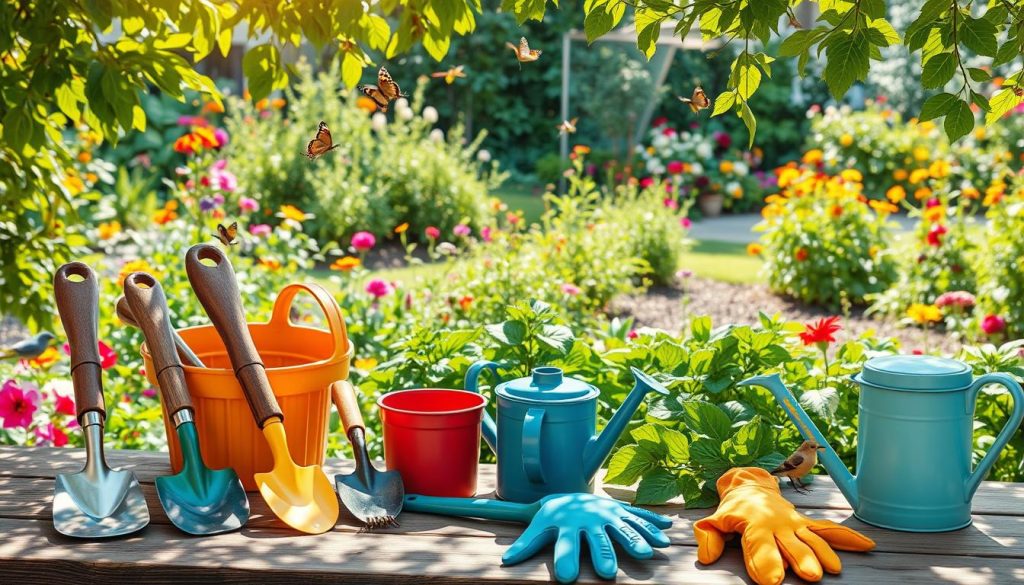
“Gardening is the art that uses flowers and plants as paint, and the soil and sky as canvas.” – Elizabeth Murray
Gardening in Different Climates
Gardening is loved by many, but it changes with the climate and environment. Gardeners in different places need to pick the right plants, prepare the soil, and garden in ways that work best for their area.
In cool places like southeast Wyoming, the growing season is short. Early frosts can come as soon as September. To make the most of the garden time, choose plants that grow fast and use greenhouses, hoop houses, and cold frames.
In hot places like Phoenix, Arizona, the sun is strong, temperatures are high, and weeds grow fast during the monsoon. To keep a garden alive, you might need to hire experts. The heat makes gardening hard and not good for your health.
In places with rich soil, like Illinois, gardens can be very productive. Gardeners here might move to warmer areas for the winter. They keep gardening and farming alive.
No matter the climate, gardening success comes from knowing what plants need and adjusting how you garden. By facing the challenges and chances of different climates, gardeners can grow beautiful, productive gardens. These gardens bring happiness and connect us to nature.
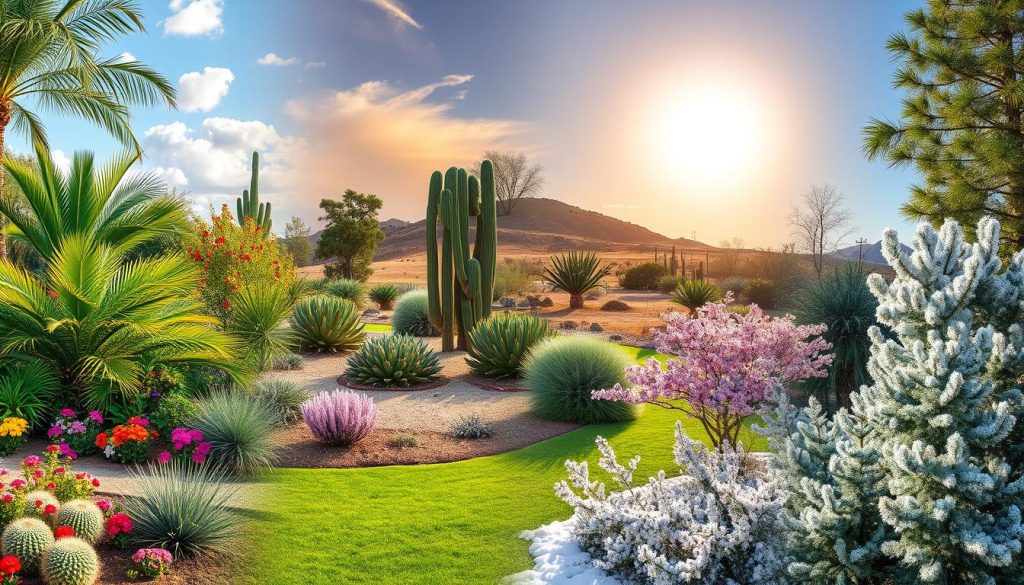
“The true essence of gardening lies in embracing the diversity of our natural world and tailoring our practices to the unique needs of each growing environment.”
Seasonal Gardening Tasks
Gardening is a year-round job, with different tasks for each season. By keeping up with these chores, gardeners can keep their gardens healthy and looking great all year.
Late Winter and Early Spring
- Research new desired plants.
- Clean out the garden shed or greenhouse.
Spring
- Transplant warm season crops after average last frost day.
- Test drip irrigation hoses for damages.
Early Summer
- Fertilize vegetables once every 2-4 weeks.
- Monitor vegetable garden daily for early pest infestations.
Summer
- Fertilize vegetable garden and perennials once per month.
- Harvest garlic when stalks turn brown.
Late Summer and Early Fall
- Stop fertilizing all plants except cool season vegetable seedlings.
- Preserve garden veggies and fruits through various methods.
Fall and Early Winter
- Sow winter cover crops over vegetable garden.
- Mow lawn to 2 inches and fertilize.
Winter
- Rest.
- Enjoy preserved harvests from the garden.
Experts suggest testing garden soil every 3-5 years for nutrients. Early spring is the best time to fix hardscaping and get the garden ready for spring bulbs.
| Season | Key Gardening Tasks |
|---|---|
| Late Winter & Early Spring | Research new plants, clean garden shed/greenhouse |
| Spring | Transplant warm-season crops, test irrigation |
| Early Summer | Fertilize vegetables, monitor for pests |
| Summer | Fertilize garden, harvest garlic |
| Late Summer & Early Fall | Stop fertilizing, preserve harvests |
| Fall & Early Winter | Sow cover crops, mow and fertilize lawn |
| Winter | Rest, enjoy preserved harvests |
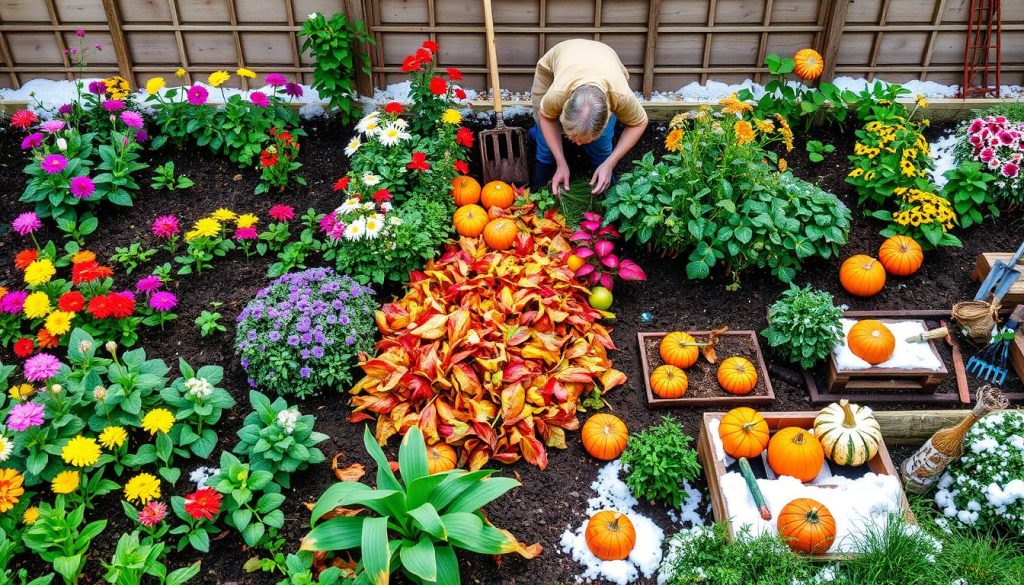
By following this seasonal gardening calendar, gardeners can stay on top of the essential tasks. This keeps their gardens thriving all year.
Gardening for Pollinators
Gardeners can help local pollinators by using pollinator-friendly plants and practices. Bees, butterflies, hummingbirds, and other insects are key to our ecosystem’s health. By making gardens welcoming for these creatures, gardeners support their local ecosystems.
Planting native plants is a great way to attract pollinators. These plants fit well with the local climate and soil, needing less care. They also offer a steady food source for native pollinators. Choose plants that bloom at different times to keep nectar and pollen available all season.
Adding water sources is also key for a pollinator-friendly garden. A birdbath or shallow dish with water and stones can be a welcome spot for pollinators. It’s important to avoid harmful pesticides, as they can harm beneficial insects and disrupt the garden’s balance.
Using sustainable gardening practices helps too. Try organic mulches, natural pest control, and letting some areas of your yard be wild. Getting advice from local experts or conservation groups can help with plant choices and pest management.
Gardening for pollinators is rewarding and vital for our ecosystems. By using these simple strategies, you can support pollinators and other species that rely on them. This helps ensure a brighter future for our planet.
Gardening as a Sustainable Practice
Gardeners can greatly impact the environment. By using sustainable gardening, we can lessen our ecological footprint. We can also save natural resources and help our local ecosystem.
At the core of sustainable gardening is using organic materials. Adding compost and mulch helps feed your plants without harming the environment. Sustainable gardening also focuses on saving water by using drip irrigation and collecting rainwater.
Choosing diverse, resilient plants is another key part of sustainable gardening. Native plants need less care and fight off pests better. This helps your garden and supports local wildlife, which is good for nature.
Thinking about waste in gardening is important too. Composting garden waste turns it into soil that helps your plants grow. By doing this, you make your garden better and help the planet.
“Sustainable gardening is not just about growing plants – it’s about growing a better future for our planet.”
Starting a sustainable garden makes a big difference. Every choice you make helps the environment. It can lead to a greener world for the future.
Conclusion
As we wrap up this detailed gardening guide, it’s clear that anyone can have a thriving garden. By learning the basics of gardening success, like preparing the soil and choosing the right plants, you can grow a green thumb. This leads to a beautiful and productive home garden.
For both new and experienced gardeners, this article offers valuable advice. It helps you face gardening challenges with confidence. By focusing on sustainable gardening, you improve your food security and help the environment. You also join a movement towards self-sufficiency and caring for our planet.
Remember these key gardening takeaways and start your gardening journey. Aim for a garden that gives you fresh, tasty food and a sense of accomplishment. With time, effort, and a touch of green thumb magic, you’ll achieve gardening success. You’ll also feel closer to nature.
